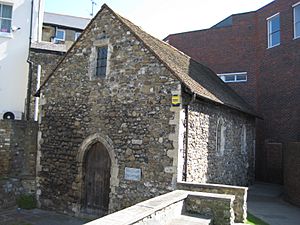St Edmund's Chapel facts for kids
St Edmund's Chapel is a very old church in Dover, England. It is named after Saint Edmund. This special chapel was finished in 1262. It was built as a "wayside chapel," which means it was a place for travelers to stop and rest. It also served as a "chapel of rest" for a nearby cemetery where poor people were buried.
The chapel was located just outside the old medieval town walls, near a place called the Maison Dieu. It was also a stopping point for pilgrims. These were people traveling to visit the holy shrine of Thomas Becket at Canterbury Cathedral. Monks from Dover Priory had created the cemetery next to the chapel.
Contents
The Chapel's Design
The chapel is about 28 feet long and 14 feet wide. Its walls are two feet thick and made of strong stone. It uses special Caen stone for its corners, called quoins, and for other decorative parts.
A Special Consecration
The chapel was first made holy, or "consecrated," on March 30, 1253. This was done by Bishop Richard of Chichester. He gave his last sermon there, saying he had always wanted to consecrate a church in honor of Saint Edmund. The very next morning, during a church service, he became ill and was taken to the Maison Dieu. He passed away there on April 3.
Because Bishop Richard died so soon after consecrating the chapel, his internal organs were placed inside the chapel's altar. This was done before his body was taken to Chichester Cathedral for burial. Due to this event and the chapel's dedication to Saint Edmund, it became a holy place that many people visited.
Changes Over Time
During the time of the Dissolution of the Monasteries, around 1544, the chapel, the Priory, and the Maison Dieu were all closed down. After this, the chapel was likely used as a storage building. It might have held supplies for the Navy or for shops that were built nearby.
In the mid-1800s, the chapel was changed into a two-story building. It became a house and a place where a blacksmith worked.
Surviving Challenges
In 1943, during World War II, artillery shells from large guns across the English Channel hit the area. These shells destroyed two shops that were hiding the chapel from Priory Road. Amazingly, the chapel itself was not damaged.
Later, in 1963, there were plans to tear down the chapel. But a local Catholic priest, Father Tanner, became interested in saving it. He bought the chapel privately two years later.
Restoration and Reopening
Starting in 1967, the chapel went through a one-year project to restore it. Workers used old medieval building methods. Today, about 75 percent of the building you see is original. The chapel was made holy again in 1968.
During the restoration, archaeologists also studied the site for four days. In 1973, the building was given a special protection status called a grade II* listing. This means it is a very important historical building.
Today, St Edmund's Chapel is an "ecumenical chapel." This means it is used by different Christian groups. It is looked after by The St Edmund of Abingdon Memorial Trust. While it used to be open to the public often, it now opens less frequently. It is still used for some church services, like a Saturday morning Eucharist and special candle-lit services.
On Good Friday, April 18, 2014, the Archbishop of Canterbury, The Most Reverend Justin Welby, visited the chapel. He said prayers there. This was likely the first visit by an Archbishop of Canterbury in many centuries.


